TIBET'S WHEEL OF LIFE
THE CYCLE OF BIRTH, DEATH,
REBIRTH AND NIRVANA

The Buddhist Wheel of Life is one of the most important themes in paintings in Tibetan Buddhism. The initial drawing was said to have been designed by Buddha himself.
The wheel contains six realms, which can either represent existence or states of mind. A being is born into each realm according to their karma.
The realms can also be viewed as situations in life, or even personality types, such as the hungry ghosts being addicts, devas being privileged, and hell beings having anger issues.
In each of these realms the Bodhisattva, Avalokiteshvara, appears to show the way to liberation from the wheel.
A "Bodhisattva" is a person on the path toward Buddhahood. Avalokiteshvara is the Bodhisattva of infinite compassion.
We will examine the parts of the wheel below:
YAMA - LORD OF THE UNDERWORLD
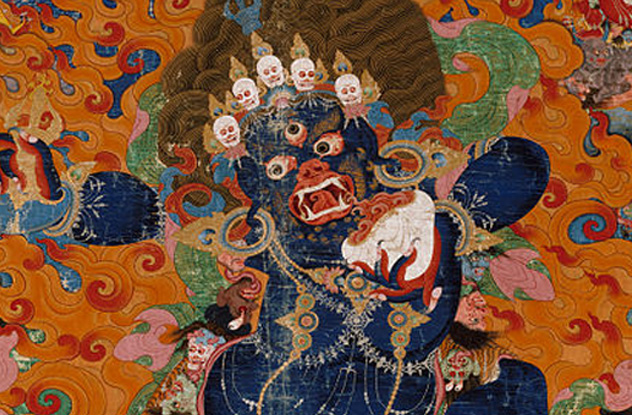
The creature holding the wheel of life in his hooves is Yama, Lord of the Hell Realm.
The horrific face of Yama represents impermanence as he peers over the wheel.
Yet despite his demonic appearance, he is not evil.
He is a wrathful creature devoted to protecting Buddhism and Buddhists.
Though we might be frightened of death, it is not evil, just inevitable.
THE HUMAN REALM
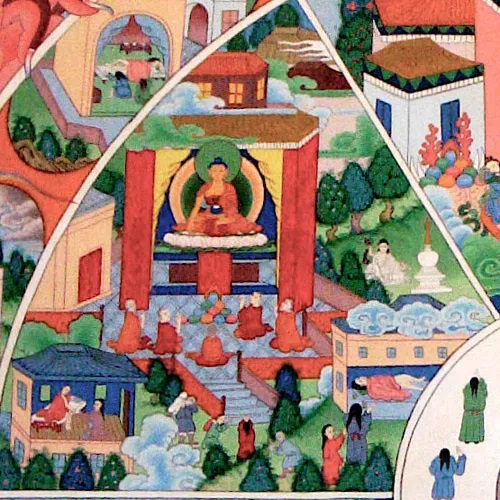
Liberation from the wheel is only possible from the human realm.
The human realm is characterized by questioning and curiosity.
Human beings wish to strive, consume, acquire, enjoy and explore.
In this realm, Dharma is openly available, and yet few seek it.
Most humans get caught up in wordly distractions and miss their chance to seek Dharma.
THE REALM OF GODS
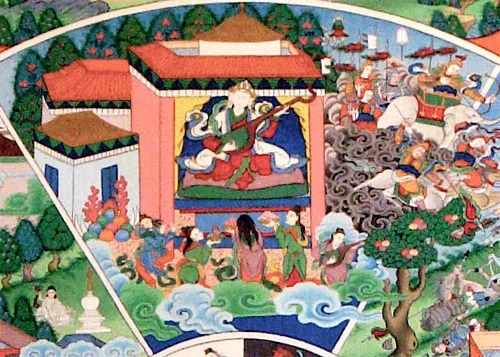
The Realm of Gods is the highest realm of the Wheel of Life. It is always depicted at the top of the wheel.
Yet even the Realm of Gods isn't perfect. Those born in this realm (Devas) have pleasure filled lives.
They have wealth and power. However, the catch is because they live such pleasure filled lives, they don't recognize the truth of suffering.
They have no reason to seek liberation from the wheel of suffering.
Eventually their pleasurable lives end and they must face rebirth in another less happy realm.
THE REALM OF ASURAS
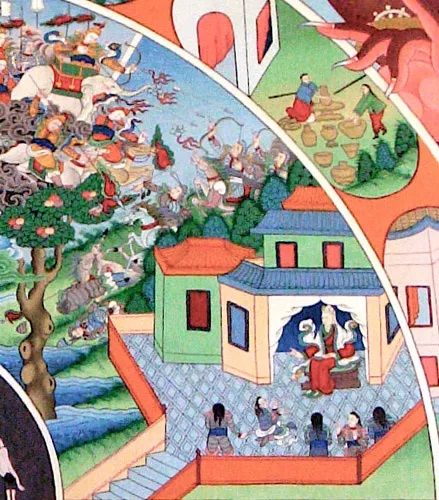
The Asuras are jealous gods marked by paranoia and a hyper competitive spirit.
They have power and resources and sometimes accomplish good things.
But their first priority is always getting to the top.
THE REALM OF HUNGRY GHOSTS
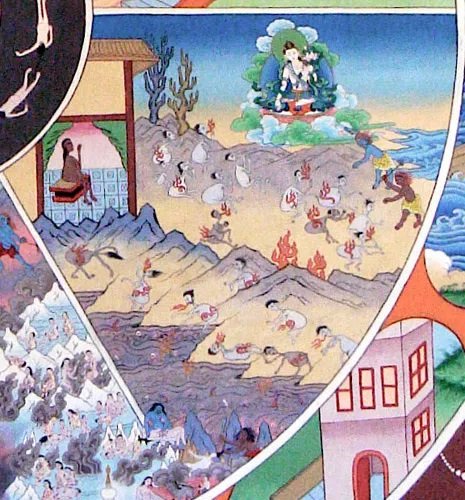
Hungry ghosts (pretas) have empty stomachs but thin necks that don't allow nourishment to pass.
Food turns to fire and ash in their mouths.
A life of greed and jealousy leads to rebirth as a hungry ghost.
Psychologically they are associated with addiction, compulsion and obsession, characteristics of people who always want more in life than what they have.
THE HELL REALM
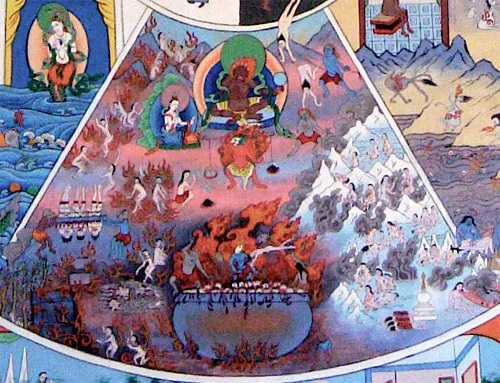
The Hell Realm is characterized by anger, terror and claustrophobia.
It is depicted as a place of fire and ice.
In the fiery part, Hell Beings (Narakas), are subjected to pain and torment. In the icy part, they are frozen.
Hell beings are full of aggression. Icy beings shove others away with their feelings of coldness and become inwardly destructive.
THE ANIMAL REALM
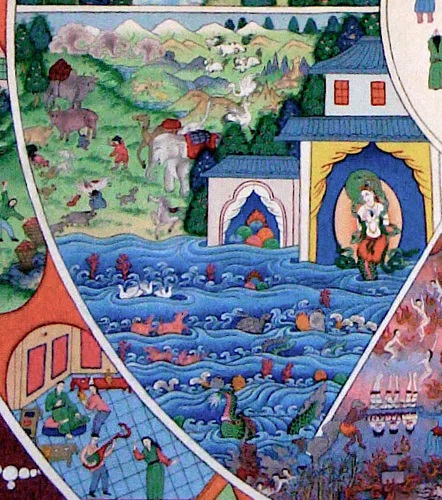
Animal beings (Tiryakas) are reliable and predictable.
They cling to what is familiar and distrust anything unfamiliar.
The Animal Realm is characterized by ignorance and complacency.
THE CENTER
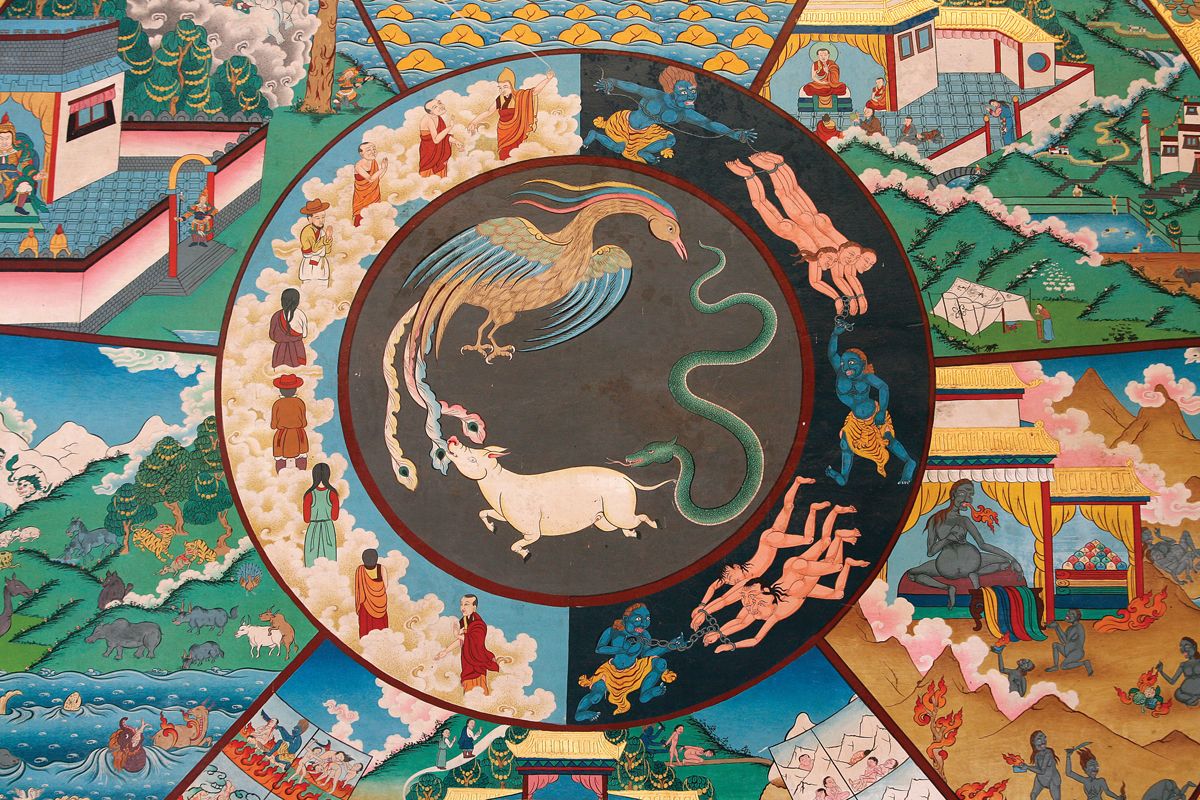
The center of the Wheel of Life are forces of greed, anger and ignorance that keep it turning.
At the center of every Wheel of Life painting is a cock, snake and a pig, which represent greed, anger and ignorance.
These are called the three poisons in Buddhism because they are poisons to whoever harbors them.
The circle outside of the center is the Sidpa Bardo, or intermediate state.
It is also sometimes called the white path and the dark path.
On one side bodhisattvas guide beings to rebirths in the higher realms. On the other side, demons lead beings to lower realms.
THE UPPER RIGHT HAND CORNER
THE BUDDHA

In the upper right hand corner the Buddha appears, representing hope for liberation.
In many of the Wheel of Life paintings, this figure is a Dharmakaya Buddha, a "truth body," or a dharma body, associated with Shunyata.
Shunyata is a difficult concept to briefly explain, but it is often translated to "emptiness."
It is a Buddhist concept with multiple meanings, including "non-self" nature, a meditative state or experience, empty awareness.
Often the Buddha in the upper right hand corner of the wheel is pointing to the moon, which represents enlightenment.
THE UPPER LEFT HAND CORNER
ESCAPING THE WHEEL - ACHIEVING NIRVANA

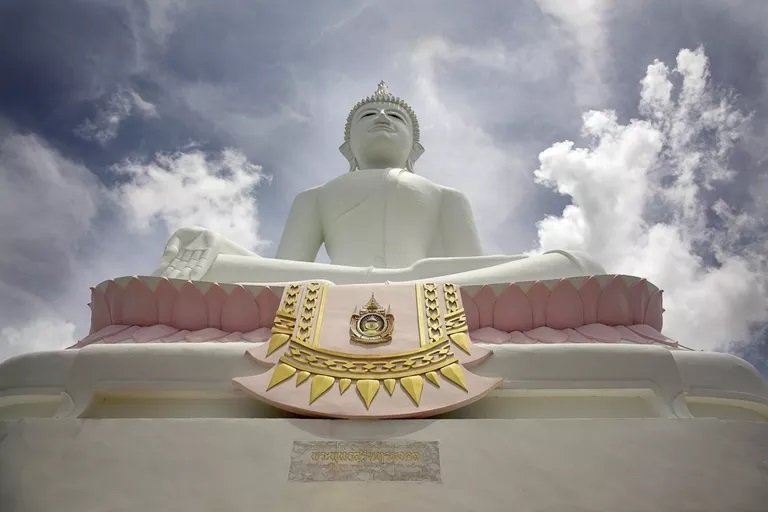
In the upper left-hand corner of the wheel of life is a temple with a seated Buddha.
A stream of beings rise from the human realm toward the temple, which represents Nirvana.
In the spiritual definition, nirvana (or Nibbana in Pali) is an ancient Sanskrit word that means something like "to extinguish," with the connotation of extinguishing a flame.
This doesn't mean obliterating oneself. It means to liberate oneself from the cycle of Samsara, the cycle of birth, death and rebirth.
LINKS